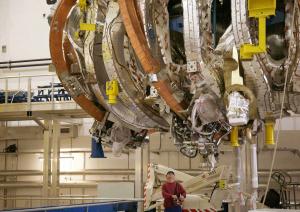Thomas Klinger was the guest speaker at the Inside ITER presentation last Thursday. His talk and subsequent interview provided some fascinating insights into the W 7-X project and, more generally, on the future of the stellarator—the bright kid who is now getting a second chance.
Asked how stellarators are different from tokamaks, Klinger uses this image: "In a stellarator, confining the plasma is like holding a broomstick firmly in your fist; in a tokamak, it's like trying to balance the same broomstick on your finger."
Stellarators produce intrinsically stable plasmas with no or only modest electrical currents flowing through them; tokamaks, with very strong plasma currents, must devise complex ways of maintaining their equilibrium. "Both are terrible beasts," smiles the Scientific Director of W 7-X. "Ours is a beast to build; yours is a beast to operate."
One doesn't obtain stable plasmas, however, without some engineering effort: W 7-X is a baroque arrangement of twisted coils (20 of them "planar", 50 "non planar"), each uniquely twisted and contorted as if crumpled by an angry giant's fist. The outer vessel has so many openings and "domes" (500!) that Thomas Klinger likes to call it "a big hole with some steel around it..."
W 7-X aims at producing 30 minute pulses, a duration that is limited only by the cooling power of the installation. "Steady-state operation is inherent in stellarators. For tokamaks, steady-state operation is still on the to-do list..."



